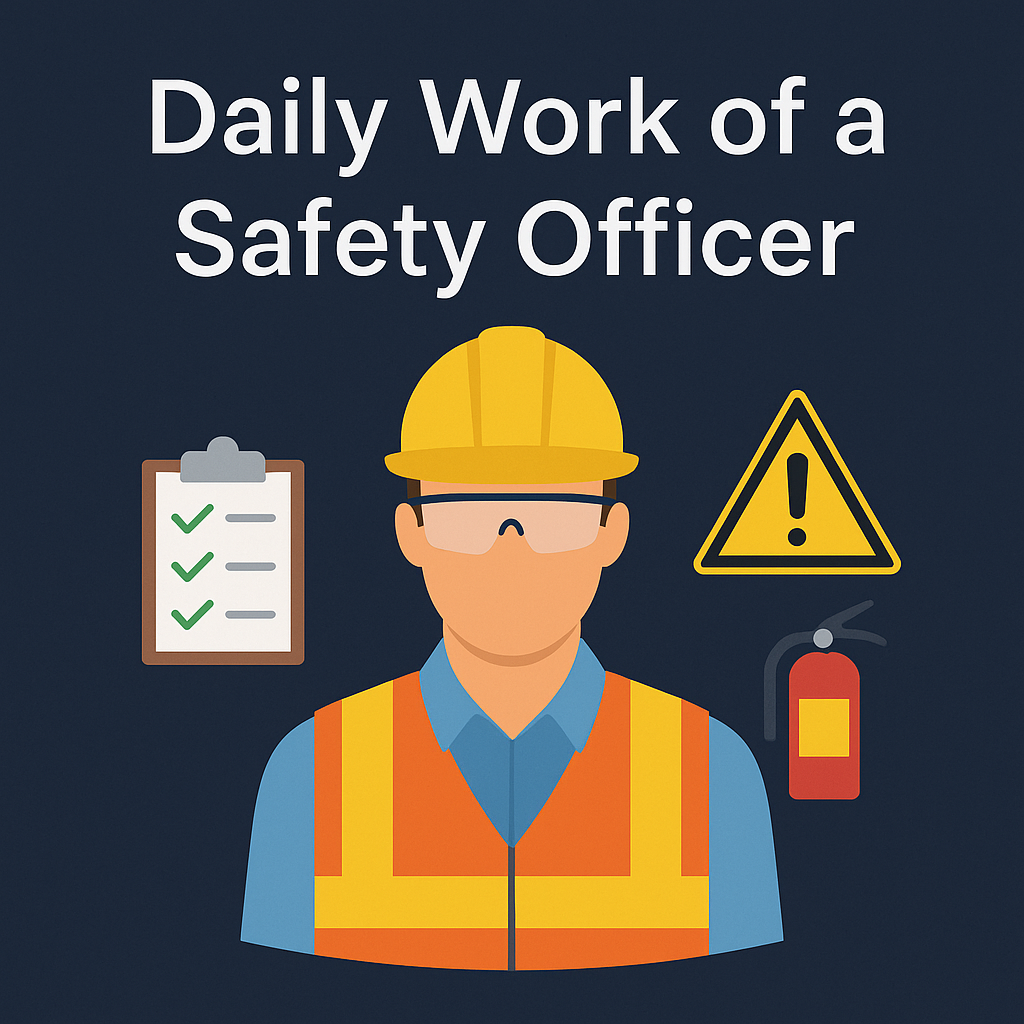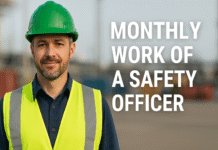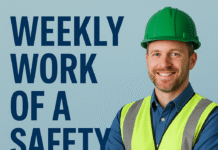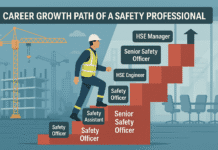
Daily Work of a Safety Officer
When you think about a workplace—whether it’s a bustling construction site, a noisy manufacturing plant, or a high-risk oil and gas facility—the one person standing as a guardian of health and safety is the safety officer. Their daily work might not look glamorous, but it is one of the most critical roles for ensuring everyone gets home safe at the end of the day.
A safety officer’s job is a blend of observation, prevention, enforcement, and education. They aren’t just rule enforcers; they are coaches, problem-solvers, and sometimes even mediators between production pressures and safety priorities. This article explores the daily work of a safety officer in detail—from the moment they step on-site to the time they close their daily reports at the end of the day.
Starting the Day as a Safety Officer
A safety officer’s day usually begins early. Unlike many other professionals, they often need to be on-site before most workers arrive. Why? Because preparation is the key to prevention.
The first task is to review incident reports, near-miss records, and safety logs from the previous day or shift. This gives them insight into what went wrong, what could have gone wrong, and what needs immediate attention. For example, if there was a near-miss during crane lifting yesterday, the safety officer ensures that today’s inspections prioritize lifting gear and rigging activities.
Next comes preparing the daily safety checklist. This checklist acts as their roadmap for the day, including items like PPE checks, site inspections, training sessions, and follow-ups on ongoing corrective actions. Without this plan, it’s easy to get lost in the chaos of a busy worksite.
Morning Safety Briefings
Before workers begin their tasks, the safety officer organizes toolbox talks or pre-start meetings. These are short, focused sessions designed to refresh workers’ awareness of potential hazards and remind them of safe work practices.
For example, if hot work (welding and cutting) is planned for the day, the briefing might cover fire safety precautions, use of fire blankets, and positioning of fire extinguishers. If the work involves working at height, the officer emphasizes fall protection, harness inspections, and proper anchorage points.
Morning briefings are also a chance to encourage workers to speak up about hazards. A good safety officer doesn’t just talk; they listen. Workers on the ground often notice issues—like slippery surfaces, faulty tools, or unstable scaffolding—before anyone else. By encouraging open dialogue, safety officers create a culture of safety ownership.
Worksite Inspections
Once the shift begins, the safety officer starts their most visible activity—worksite inspections. This is where they walk through different areas of the workplace, observing workers, equipment, and site conditions.
During inspections, they check for:
- PPE compliance – Are workers wearing helmets, gloves, goggles, and safety shoes?
- Machine and tool safety – Are guards in place? Are tools properly maintained?
- Work environment hazards – Any slip, trip, or fall hazards? Is housekeeping maintained?
- Unsafe acts – Are workers bypassing safety protocols?
For instance, a safety officer might spot a worker grinding metal without wearing a face shield. Instead of just issuing a warning, a good officer explains the risk: “One small spark could damage your eye permanently. Let’s put on the correct shield.” This approach makes the correction educational rather than punitive.
Risk Assessments & Hazard Identification
No two days are the same on a worksite, which means new risks can appear daily. That’s why safety officers regularly conduct Job Hazard Analysis (JHA) or Task-Based Risk Assessments (TBRA).
Imagine excavation work starting in a new area of the site. The safety officer must assess soil conditions, check for underground utilities, and ensure protective systems like shoring or trench boxes are in place. Similarly, if electrical installation is planned, they need to verify lockout/tagout procedures are being followed.
This step ensures hazards are identified before accidents happen. It’s proactive safety at its best—spotting danger before it becomes disaster.
Monitoring Permit to Work (PTW) System
High-risk tasks such as hot work, confined space entry, electrical isolation, or working at height cannot be carried out without a Permit to Work (PTW) system. The safety officer plays a critical role in verifying that permits are issued, understood, and followed.
For example:
- Hot Work Permit – Ensuring fire extinguishers are nearby, and flammable materials are cleared.
- Confined Space Permit – Checking for gas testing, proper ventilation, standby attendants, and rescue plans.
- Electrical Work Permit – Verifying isolation, grounding, and insulated tools.
By monitoring permits, the officer ensures that procedures aren’t just paperwork but are practically enforced on the ground.
Ensuring PPE Compliance
Personal Protective Equipment (PPE) is often called the “last line of defense” in safety. While engineering controls and administrative measures come first, PPE is still vital.
The safety officer ensures that:
- Helmets are worn correctly (not just balanced on the head).
- Safety harnesses are inspected and secured at proper anchorage points.
- Gloves and protective footwear are used as per the task.
- Workers understand why PPE matters—not just that it is mandatory.
For example, in a steel plant, a worker once refused to wear earplugs, thinking they were unnecessary. The safety officer explained how long-term noise exposure leads to permanent hearing loss—a silent hazard that creeps up without warning. The worker, realizing the seriousness, started using earplugs consistently.
Supervising High-Risk Activities
Some tasks are inherently dangerous and require direct supervision. A safety officer doesn’t just “check and leave”—they often stay nearby to monitor until the task is complete.
1. Working at Height
They verify scaffolds are properly erected, ladders are secured, and fall arrest systems are in place. They also check if weather conditions, like strong winds, make work unsafe.
2. Excavation and Trenching
Trenches deeper than 1.5 meters can collapse suddenly, burying workers. The officer ensures protective systems like benching, sloping, or trench boxes are used.
3. Lifting and Rigging Operations
Cranes, forklifts, and chain blocks are common lifting tools. The officer checks for safe load limits, proper signaling, and exclusion zones to prevent accidents from dropped loads.
By being present, they not only enforce safety but also provide immediate corrective guidance.
Incident Prevention and Control
An important part of daily work is preventing accidents before they happen. Safety officers encourage workers to report near-misses—incidents that could have caused harm but didn’t. Each near-miss is treated as a free lesson to prevent future accidents.
For example, if a worker trips over an extension cord but doesn’t fall, the safety officer ensures the cord is relocated or secured immediately. Ignoring it could mean the next worker actually falls and gets injured.
They also implement corrective actions like barricading, signage, or temporary stoppages of unsafe work until hazards are controlled.
Emergency Preparedness and Drills
One of the most underrated yet vital duties of a safety officer is ensuring the workplace is prepared for emergencies. Emergencies are unpredictable—fires, chemical spills, gas leaks, or structural collapses can happen anytime. A safety officer’s role is to make sure that if they do occur, the damage is minimized.
Daily, this means:
- Checking fire extinguishers – Are they in the right locations, within expiry, and properly tagged?
- Inspecting emergency exits – Are escape routes clear of obstructions? Are exit lights working?
- Ensuring first-aid kits are stocked and accessible.
But preparation doesn’t stop there. Safety officers often schedule mock drills to test readiness. For example, a fire drill might involve sounding alarms, evacuating workers, and timing the process. If evacuation takes too long, the officer reviews the drill and finds solutions—like installing better signage or improving awareness.
This proactive approach builds confidence among workers, so when a real emergency strikes, panic is reduced, and actions are automatic.
Coordination with Supervisors & Management
Safety is not a one-man show. A safety officer must coordinate daily with supervisors, engineers, and management teams.
They attend planning meetings where tasks for the day are discussed, raising safety concerns early. For example, if concrete pouring is planned near live electrical lines, the safety officer will highlight the need for isolation or protective barriers.
This coordination ensures that safety is integrated into operations, not treated as an afterthought. Effective officers also keep communication open both ways—updating management on hazards while also listening to supervisors about production challenges.
This role as a bridge between safety and productivity is one of the hardest but most crucial parts of the job.
Documentation and Reporting
If there’s one part of a safety officer’s job that consumes a large chunk of time, it’s documentation. Safety without records doesn’t stand in audits, inspections, or legal cases.
Daily documentation includes:
- Inspection checklists – covering equipment, PPE, housekeeping, and work areas.
- Permit-to-Work logs – confirming that all high-risk permits are valid and closed properly.
- Incident and near-miss reports – even if nothing major happens, every observation is recorded.
- Daily safety reports – summarizing the day’s inspections, violations, corrective actions, and training conducted.
Though it may seem tedious, this paperwork is what proves compliance with OSHA or local safety laws. It also helps track trends over weeks and months. For example, if repeated near-misses are reported at one scaffolding area, management can prioritize corrective measures like redesigning the scaffold system.
Training and Awareness Sessions
Training is not just a one-time induction. A safety officer provides continuous learning opportunities through short, focused sessions.
- Toolbox Talks (TBTs): These 5–10 minute sessions are conducted before shifts to refresh awareness.
- Micro-trainings during breaks: Topics like safe lifting techniques, fire extinguisher use, or electrical safety can be covered.
- Formal training programs: Sometimes, officers organize longer sessions on specialized topics such as confined space entry, working at height, or first-aid.
For example, a safety officer might notice workers not using hearing protection in a noisy area. Instead of just warning them, they arrange a quick awareness talk, showing how hearing loss develops silently over years of exposure. This kind of practical storytelling makes workers take safety more seriously.
Dealing with Contractors & Visitors
Construction and industrial sites often have multiple contractors and frequent visitors. Each new face is a potential risk if they are unaware of safety rules.
That’s why the safety officer conducts site inductions. These cover:
- Site-specific hazards (like heavy equipment movement or chemical storage).
- PPE requirements.
- Emergency procedures and assembly points.
- Restricted zones.
For visitors, the induction may be short, but for contractors, it’s more detailed—sometimes including written tests to ensure understanding.
This ensures everyone entering the site is aligned with safety culture, not just permanent employees.
End-of-Day Responsibilities
As the day winds down, the safety officer’s job doesn’t stop. Before leaving, they:
- Review all inspections – checking if identified hazards were corrected.
- Follow up on non-compliances – ensuring violations are closed, not ignored.
- Prepare daily reports – to be shared with management.
- Plan for the next day – based on upcoming work activities and potential risks.
This end-of-day routine ensures continuity, so the next shift or next day begins with safety already in focus.
Challenges Faced by Safety Officers
Being a safety officer is rewarding but far from easy. Daily challenges include:
- Worker resistance – Some workers see safety as slowing down production. Officers must educate without alienating them.
- Production vs. safety conflict – Management may push deadlines, making safety seem secondary. The officer must balance both.
- Cultural differences – On multinational sites, workers from different backgrounds may have different safety perceptions.
- High-stress environment – The responsibility of preventing accidents can be mentally exhausting.
Great safety officers use **soft skills—patience, communication, and diplomacy—**to handle these challenges while still enforcing compliance.
Why the Daily Work of a Safety Officer Matters
Some may wonder: why so much detail for daily routines? The answer is simple—lives depend on it.
Every PPE check, every hazard observation, and every briefing prevents potential accidents. Safety officers are like silent guardians: when they do their job well, accidents are prevented, and no one even realizes the disaster that was avoided.
Their work doesn’t just meet compliance standards—it builds a culture of safety where workers look out for each other, and safety becomes second nature.
Conclusion
The daily work of a safety officer is demanding, detailed, and deeply impactful. From morning toolbox talks to late-evening reporting, their actions weave a protective net around every worker. They are not just enforcers of rules but educators, motivators, and life-savers.
Without safety officers, workplaces would be far more dangerous, and accidents would be far more frequent. Their daily grind ensures safety isn’t just a priority—it’s a way of life.
External link: (OSHA official site)
Career Growth Path of a Safety Professional (From Fresher to HSE Manager)
Safety Officer Salary in India and Abroad 2025 (Updated)
Top 10 Safety Courses for a Successful Career in HSE
How to Become a Safety Officer After Graduation?
Role and Responsibility of a Safety Officer
FAQs
1. What is the first task of a safety officer each day?
They usually begin by reviewing incident reports and preparing the daily safety checklist.
2. Do safety officers only inspect, or do they also train?
They do both. Training and awareness are as important as inspections.
3. How do safety officers handle emergencies?
They prepare daily by checking emergency equipment and conducting mock drills.
4. Why is documentation so important for safety officers?
It provides evidence of compliance, supports investigations, and identifies long-term safety trends.
5. What makes the job of a safety officer challenging?
Balancing safety with production demands, handling worker resistance, and managing stress in high-risk environments.
























